The battle over a vast New York park: is this climate resilience or capitalism?

The city’s plan to rebuild Manhattan’s East River Park on higher ground has incited a dispute over ‘green gentrification’
A strip of land that borders New York’s East River has become the latest environmental justice battle as the city prepares to start construction on a flood prevention project in one of Manhattan’s most economically disadvantaged and diverse communities.
East River Park, which covers 57.5 acres and loops around lower Manhattan like a hockey stick, is about the only waterfront green space within walking distance of the Lower East Side’s public housing. During Hurricane Sandy, both the park and much of the nearby housing were significantly damaged by historic levels of flooding.
Nine years later, city planners have approved a plan to raze the park, bury it under eight feet of new soil, and build a redesigned park on higher ground. The new, elevated park would serve as a buffer from storm surges and protect residents in the Lower East Side from flooding.
At a time when the city is grappling with how to fortify neighborhoods across the five boroughs from devastating floods – such as the ones brought recently by Hurricane Ida – the plan to rebuild East River Park stands out, at a cost of $1.45bn.
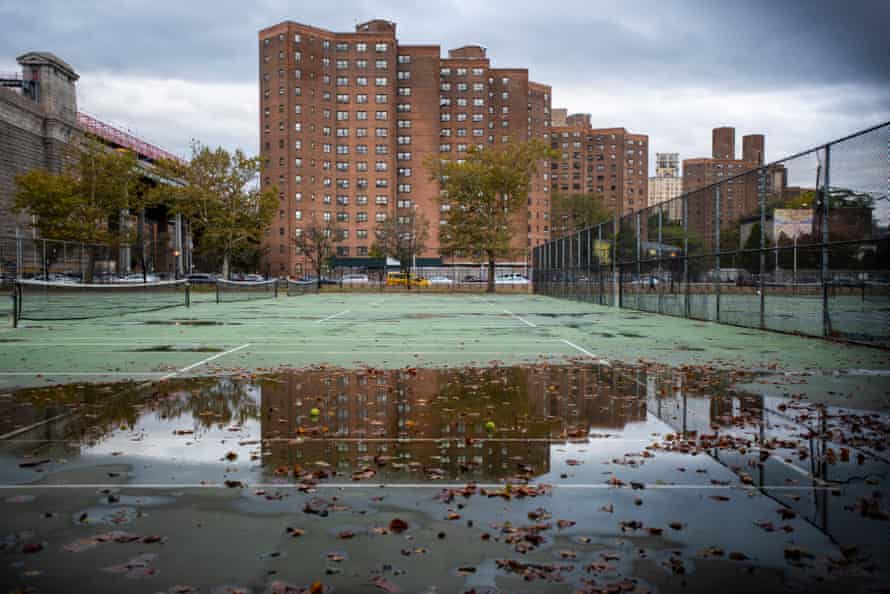
But the plan is increasingly mired in controversy. A vocal opposition group, East River Park Action (ERPA), rejects the idea that the local neighborhood must lose access to vital green space (while the park is being rebuilt) in order to ensure a future free of floods. Members say the city had a better, more equitable and environmentally friendly plan for the park on its hands, which was scrapped unceremoniously for this lesser project.
The ERPA group has garnered media attention for its continued opposition to the plan to tear down and rebuild the park, calling it both unsafe and unjust. Nearly a quarter of residents in the Lower East Side and Chinatown neighborhoods are rent-burdened, and ERPA says the city has not fully considered their needs – including reliable access to green space.
ERPA activists are also concerned that big, expensive development projects beget bigger, more expensive development projects; members frequently describe the city’s plan as a kind of Trojan horse for gentrification.
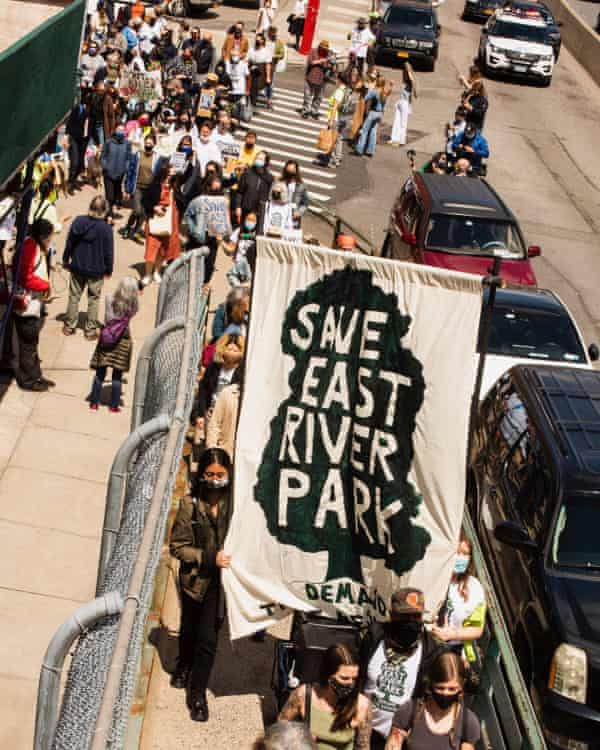
Many residents share this view, and are skeptical the city has their best interests at heart. In 2019, more than 1,800 tenants in NYC Housing Authority apartments signed a petition expressing concerns about the park’s redevelopment. But ERPA’s members have also been accused of standing in the way of meaningful climate action, which would ultimately protect some of the city’s most vulnerable residents.
Some critics allege that ERPA activists are out-of-touch outsiders who live comfortably elsewhere, away from the park, and are trying to tell local residents – many of whom are Black or immigrants – what’s best for them.
“We all use the park, but they didn’t suffer what we did,” says Nancy Ortiz, tenant association president at the Vladeck Houses, which lost power during Sandy.
The way Ortiz sees it, losing access to the park for five years – which is the city’s timeline for completing construction – would be worth it to gain “25 to 50 years” of protection against floods.
“The longer they prolong and halt the project, the closer we got to losing the funding,” says Ortiz. She added, “Climate change is real. It’s going to get worse. We have the right to be protected and were the first ones to get hit. I’m offended by the activists. There’s no compromise with them.”
This, in a nutshell, is the debate around “green gentrification” – what kind of future can the city imagine building, and what can it actually deliver? The issue of how to proceed in East River Park has divided the community, and will serve as a test of how New York City can build consensus among all types of residents in order to move toward climate resiliency.
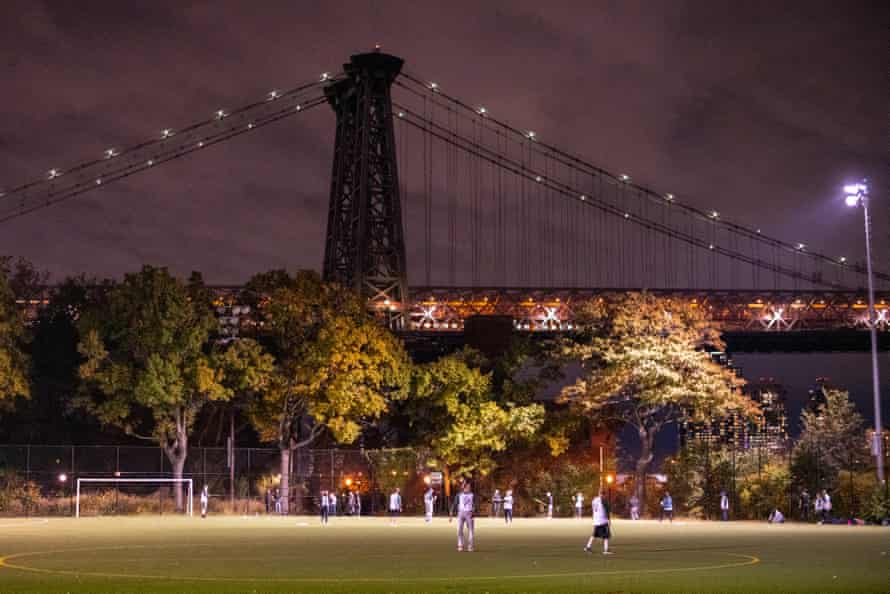
The need for surge and flood resiliency in New York City is not disputed. Once just forest and marshlands surrounded by a harbor thick with tide-slowing oyster beds, Manhattan is now covered by concrete and stone, not soil. Streams that once handled runoff are now drains that cannot cope with the intensity of rainfall in the era of climate change.
Experts say the city isn’t designed to handle the level of rainfall it is experiencing. According to a recent Bloomberg report – New York City’s Future Is Very, Very Wet – the city’s sewage system is geared to handle about 1.75in of rain an hour. On 1 September, between 8.51 and 9.51pm, Ida brought down 3.15in in Central Park.
By the end of the 21st century, the city could experience as much as 25% more annual rainfall, according to the New York City Panel on Climate Change, along with an increase in the number of days with extreme rain. In a post-Ida report, the city said that “recalibrating our sewers for storms like Ida would require a decades-long, potentially $100-billion investment.”
The road to climate resiliency is long.
But some say the East River Park plan will deprive the surrounding neighborhood of crucial environmental amenities for too long. Opponents of the plan say it is indicative of a broader trend in which climate mitigation efforts fail to take into account the needs of poorer communities and people of color.
The East River Park Action was fond of a previous plan considered by the city, which they argue also had wider support from the community. That plan, developed by the Dutch design firm Bjarke Ingels, featured a wall running along FDR Drive to prevent storm surge, and – at one point – a grass-covered berm over the highway.
The city has acknowledged that the older plan was put forward, and provisionally approved, before being scrapped in 2018 after concerns arose about its feasibility. The project would have required construction at night and force a shutdown of the highway, disrupting Nycha residents, and require the relocation of major underground power lines, which city leaders claim was unrealistic.

Political representatives for the area acknowledge that the city was less than clear in its communication about the change in plans. Months after the switch, Lorraine Grillo, then the commissioner of the city’s department of design and construction (DDC), apologized for the city’s poor communication.
The city opted for a different plan and struggled to educate residents about what it would entail. But now local leaders are trying to garner whatever public good will they can to move forward with their overall project of protecting residents from tomorrow’s climate disasters.
“The reality of addressing climate change in a dense urban environment is that it is disruptive,” says Jamie Torres Springer, commissioner at the DDC. “We have worked to minimize that disruption by phasing the closure of the park and by having the parks department put in place alternative recreational resources because we recognize the impact on the community.”
Jasmin Sanchez, a field organizer for congresswoman Alexandria Ocasio-Cortez on a Green New Deal for American Public Housing Communities, says the park should be maintained as a place for Nycha residents, who may have little other access to public outdoor spaces. “Right now there are loads of people saying they don’t want this project to happen, but the mayor and our city council member Carlina Rivera just don’t seem to care.
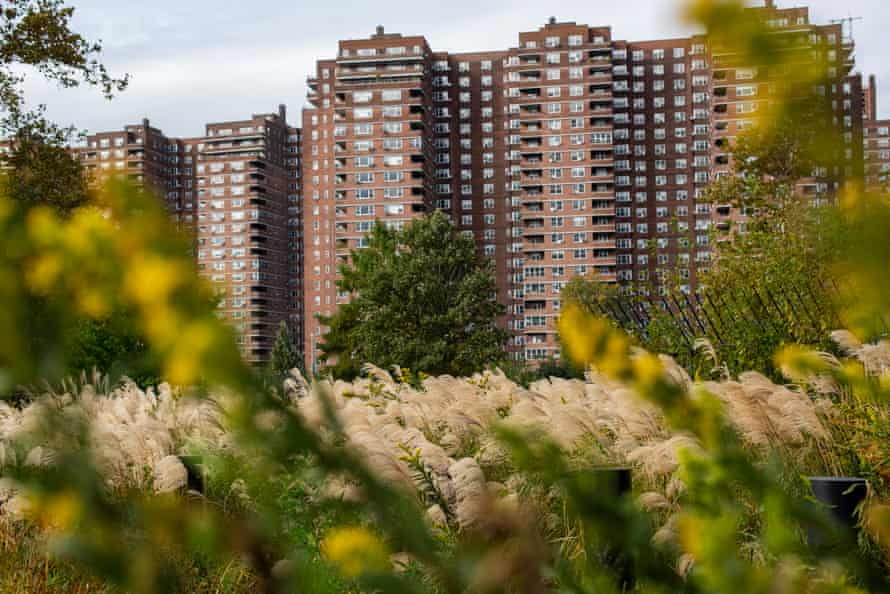
The city’s plan – called the East Side Coastal Resiliency Construction – involves closing off the park in sections until construction is complete.
“This park has always thrived because it’s the back yard for the projects,” says Clara Rodriguez, an activist with ERPA, who has periodically lived in the neighborhood around the park. “It’s home for us. The west side is fancy and people go there for the parades. But this is our home.”
Eileen Myles, the poet and author of the cult classic Chelsea Girls, points not only the shortcomings of the current proposals – “this is not a flood plan,” she says – but also to the social-cultural history of a park and its amphitheater, where Joseph Papp began Shakespeare in the Park and where parts of Charlie Ahearn’s 1983 hip-hop documentary Wild Style was filmed.
The worry that the redesigned park might accelerate gentrification in this neighborhood looms large over the activists, many of whom describe themselves as anti-development. Too often, they say, the city has promised one thing, only to run out of money and hand land over for high-priced luxury residential housing whose developers, in turn, contribute handsomely to political coffers.
The plan involves building a 1.2-mile wall along the water and covering the razed park with eight feet of soil; the cost is in the region of $1.45bn. Once work is completed, and the park replanted with about 1,800 trees, Torres Springer says, “we’re optimistic the community will have a park that will endure for many decades and will also address these climate-related risks.”

The issue of how to equitably protect the Lower East Side from climate disaster has forced many city and state leaders to pick a side between the two opposing camps. The New York attorney general, Letitia James, said in her response to the draft environmental impact statement for the new park, “the project will disproportionately impact minority and low-income people, and the City’s repeated conclusion to the contrary is incorrect.”
The fight over the future of the East River Park gets at a crucial debate that comes up whenever cities or states settle on billion-dollar infrastructure resilience projects designed to combat the impacts of the climate crisis. Independent of stronger rent control laws and tenant rights organizations, will today’s climate resiliency plans invariably lead to improved neighborhoods, higher costs of living and more opportunities for gentrification?
These are the questions that the East River Park Action group continues to highlight. But residents who live closest to the park argue that ERPA’s criticism of a decent flood protection plan threatens to delay meaningful climate action in their neighborhood.
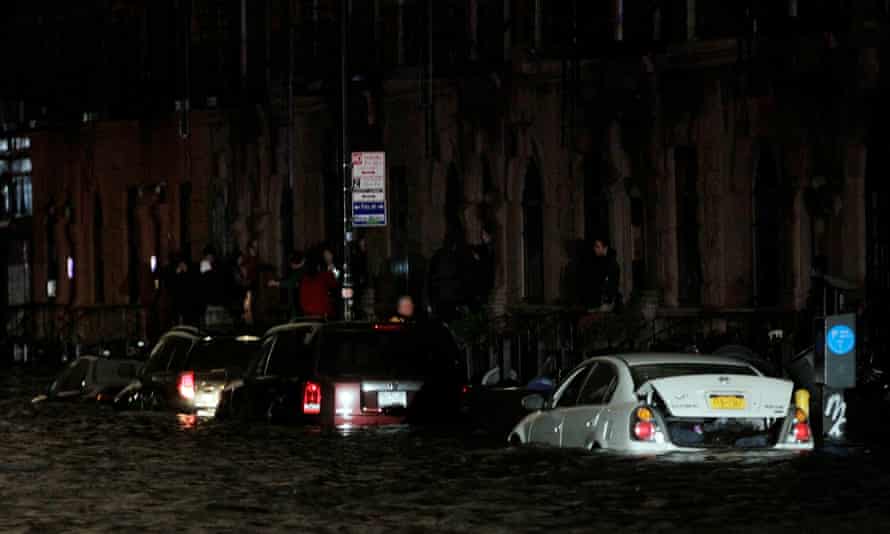
Earlier this month, an elderly Nycha resident who gave her name as Eileen said she considered the work necessary, whichever plan was chosen. Battles between the two, she opined, were largely irrelevant given the stakes. “They’ve got to do it or we’ll be underwater.” Another, who offered his name as Mike, but also requested to be identified by first name only, said that anyone who experienced the flooding from Hurricane Sandy would understand. “I don’t want the park to go, but the fact remains something has to be done.”
Another Nycha housing resident, Jennifer Cumming, 40, who lived through Sandy’s flooding, said ultimately she supported the city’s plan. “If they want to expand the park, make it prettier and more usable, that’s a good idea.” But she acknowledged it was a complicated issue that has sparked “mixed feelings” on both sides. “Some say it’s a good idea, because they’ll expand it; some say they’re destroying a landmark.”
Trever Holland, the parks chair of community board three, which includes the park, rejects the idea that razing the park is a slippery slope to gentrification. “It’s easy to inflame people by saying the entire park is going to be destroyed and they’re going to put up luxury buildings,” he argues.
“There’s a false narrative that in lower-income neighborhoods, especially neighborhoods of people of color, people don’t like investments in infrastructure. And that’s just not correct.”
Still, some residents are worried about losing their home – not to flooding, but to sky-high cost of living – and some say it’s already happening.
“The plan is ultimately to redevelop all of this,” said Nycha resident Mike Jones, waving his arm across the expanse of the neighborhood. “We’re getting priced out. Developers and politicians think long-term. Nycha is failing, so private developers will definitely take over. It will happen.”
But the battle in a sense showcases discord that always existed between city administrators and the least privileged of its residents – discord that is now amplified by climate change.
As the leaves begin to turn brown on the mature plane trees in the park, it’s highly likely they won’t see another spring. The city, like countless others around the world, is obliged to protect itself and its residents in the face of melting polar ice caps, intensifying hurricanes and the storms that are, in a manner of false reassurance, termed “rain events”.
“The city is a capitalist automaton that can’t stop itself,” says Sarah Wellington, an activist who has attended several protests. “The city has backed itself into a corner. They pushed this, and now they don’t know how to get out of it.”
